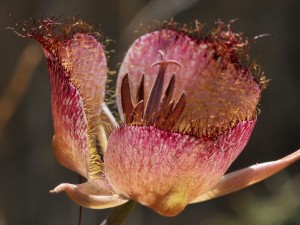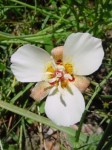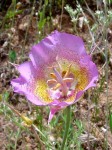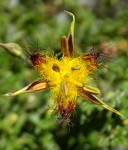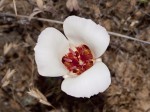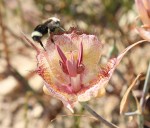Calochortus
Mariposa — or “butterfly” in Spanish — is a fitting name for these colorful flowers that thrive in harsh environments despite their delicate appearance. Out of the 67 different species of mariposa lilies in the world, 45 of them are found in California, including twelve different species found throughout the Los Padres National Forest.
The mariposa lily is capable of surviving in hot, dry conditions, often on rocky outcrops where other plants cannot grow. It sprouts each year from an underground bulb that can support several flowers. The flowers bloom in late spring or early summer and have three colorful petals with long hairs on the surface. In the fall, the flowers shed their seeds which germinate following winter rains. Several years may pass before a bulb reaches maturity and produces a flower.
The fact that the mariposa lily grows from a bulb gives it some interesting qualities, including the ability to survive wildfires. Because the bulb is buried deep enough underground, the plant can survive most fires even when its above-ground portion is burned. Following wildfires, these bulbs produce greater numbers of flowers than in average years, taking advantage of the nutrient-rich soil and the lack of competition from other plants. This trait has contributed to the success of the mariposa lily in fire-prone environments. Historically, the bulbs were used as a food source by Native Americans living in the area.
Despite the fact that these flowers are hearty, five species of mariposa lily in the Los Padres National Forest are classified as “sensitive” because their population levels are declining, threatening the species’ ability to survive. These sensitive species include:
Palmer’s Mariposa Lily
Calochortus palmeri var. palmeri
- Sensitive – U.S. Forest Service
- Sensitive – Bureau of Land Management
- Rare Plant Rank 1B.2 – California Native Plant Society
- T2 Imperiled – NatureServe (1997)
Palmer’s mariposa lily occurs in many areas of the Los Padres National Forest. Among other places, it has been noted in the Sespe Watershed along the Chorro Grande Trail, on the north slope of Frazier Mountain, within eastern Lockwood Valley, and within the La Panza Range. Palmer’s mariposa lily occurs in meadows and along small streams where soil is wet for much of the year, but dry during the summer.
Plummer’s Mariposa Lily
Calochortus plummerae
- Sensitive – U.S. Forest Service
- G4 Apparently Secure – NatureServe (2013)
Plummer’s mariposa lily is found at elevations of up to 5,580 feet and has pink flowers covered with yellow hairs. It is most often found in chaparral or coastal scrub ecosystems and sometimes found in grasslands, oak woodlands, or pine woodlands at the southern fringe of the Los Padres National Forest. It is restricted to southern California and found nowhere else on Earth.
San Luis Mariposa Lily
Calochortus obispoensis
- Sensitive – U.S. Forest Service
- Sensitive – Bureau of Land Management
- Rare Plant Rank 1B.2 – California Native Plant Society
San Luis mariposa lily is endemic to San Luis Obispo County and found nowhere else. It is restricted to the Cuesta Ridge Botanical Special Interest Area of the Los Padres National Forest. They are also found on rocky outcrops to the southeast and north of San Luis Valley. Individual bulbs of this species may live for more than 10 years! The San Luis mariposa lily is found in dry soils within chaparral, coastal scrub, or grassland ecosystems.
San Luis Obispo Mariposa Lily
Calochortus simulans
- Sensitive – U.S. Forest Service
- Rare Plant Rank 1B.3 – California Native Plant Society
- G2 Imperiled – NatureServe (1988)
The San Luis Obispo mariposa lily is endemic to San Luis Obispo and Santa Barbara counties, ranging from the Santa Lucia Mountains to the front country of the Sierra Madre Ridge. This lily is found in grassland, chaparral, woodland, and low elevation forest ecosystems in sandy and granitic soils.
Late-flowered Mariposa Lily
Calochortus fimbriatus
- Sensitive – U.S. Forest Service
- Rare Plant Rank 1B.3 – California Native Plant Society
The late-flowered mariposa lily – which blooms well into August – is found in the Santa Lucia Mountains in southern Monterey County and on the southern slope of the Santa Ynez Mountains from Hollister Ranch to Santa Paula Peak. It grows in a variety of areas but is most successful on rocky ground where there is less competition from other plants.
Threats and Conservation Issues
Mariposa lilies are threatened by grazing, development, road construction and maintenance, off-road vehicle trespass, invasive plants, vegetation clearing, and fire suppression in the Los Padres National Forest. Uncontrolled grazing by livestock can lead to the consumption and/or trampling of critical mariposa lily populations. Cattle also compact the soil on lands that are extensively grazed, making it difficult for new plants to take root. Several mariposa lily populations along West Camino Cielo are threatened by illegal off-road vehicle trespass, which crushes the plants, uproots the bulbs, and promotes the spread of invasive weeds.
Those mariposa lilies listed as “sensitive” are supposed to receive careful protection from development and land use activities in the Los Padres National Forest. Los Padres ForestWatch keeps a sharp eye on these areas to ensure that all remaining populations of “sensitive” mariposa lilies are protected. ForestWatch has protected known mariposa lily locations from vegetation clearing projects by requiring the Forest Service to leave buffers around plants and to limit the amount of clearing that occurs. With your support, we will continue to do our best to ensure that these beautiful flowers persist within their native habitat in the Los Padres National Forest.

